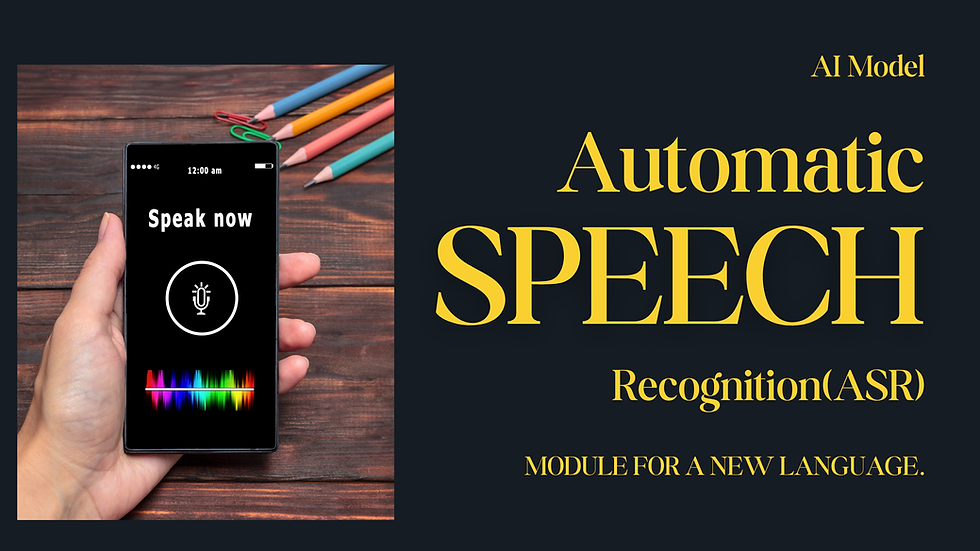
Project Overview:
Develop an Automatic Speech Recognition (ASR) module for a new language (Creole), focusing on free tech options and providing a live, working page for university project submission.
Task Breakdown:
1. Data Preprocessing:
1.1 Audio Normalization:
Implement peak normalization using Python’s librosa library to ensure consistent loudness across all audio files.
Normalize all input audio files to a standard peak amplitude, ensuring uniform volume.
import librosa
def normalize_audio(audio_path):
y, sr = librosa.load(audio_path)
peak = max(abs(y))
y_normalized = y / peak
return y_normalized, sr
1.2 Silence Removal:
Use a Voice Activity Detection (VAD) algorithm to remove silent or low-energy segments.
Implement silence removal using webrtcvad for accurate voice detection.
import webrtcvad
def remove_silence(audio):
# Implement VAD for silence removal
vad = webrtcvad.Vad(3)
# Process the audio file
1.3 Data Augmentation:
Apply techniques like speed perturbation, pitch shifting, and additive noise using librosa for augmenting the dataset.
def augment_audio(audio, sr):
y_speed = librosa.effects.time_stretch(audio, rate=1.2)
y_pitch = librosa.effects.pitch_shift(audio, sr, n_steps=2)
return y_speed, y_pitch
2. Feature Extraction:
2.1 Mel-Spectrogram:
Extract the Mel-Spectrogram using librosa and ensure it is ready for input into the deep learning model.
def extract_mel_spectrogram(audio, sr):
mel_spec = librosa.feature.melspectrogram(y=audio, sr=sr)
return mel_spec
2.2 Pitch and Amplitude Features:
Use librosa.piptrack() to extract pitch and STFT for amplitude variations.
def extract_pitch(audio, sr):
pitches, magnitudes = librosa.piptrack(y=audio, sr=sr)
return pitches
2.3 Self-Supervised Features:
Use self-supervised models like HuBERT or Wav2Vec 2.0 for extracting SSL-based features. These models can pre-train on large unlabeled audio data and then fine-tune on smaller datasets like the one I will give to you to boost recognition accuracy. Despite we do not have a pretrained model on Creole, we use it to get phonetic and linguistic patterns..
3. Tokenization:
3.1 Subword Tokenization:
Implement Byte-Pair Encoding (BPE) or SentencePiece tokenization to reduce vocabulary size and handle unknown words efficiently.
pip install sentencepiece
import sentencepiece as spm
spm.SentencePieceTrainer.train('--input=corpus.txt --model_prefix=m --vocab_size=32000')
4. Data Alignment
4.1 Forced Alignment
Use a forced alignment tool (e.g., Montreal Forced Aligner) to ensure that the transcription data is perfectly aligned with the audio. This step is important to synchronize speech segments with the corresponding text.
5. Model Architecture:
5.1 Convolutional Neural Networks (CNN) for Feature Extraction:
Add CNN layers to capture local spatial features from the Mel-spectrogram (e.g., formants and consonant clusters).
from tensorflow.keras.layers import Conv2D
model.add(Conv2D(filters=64, kernel_size=(3, 3), activation='relu'))
5.2 Bidirectional LSTM (BiLSTM):
Implement BiLSTM layers to capture both past and future context from the audio input.
from tensorflow.keras.layers import Bidirectional, LSTM
model.add(Bidirectional(LSTM(128, return_sequences=True)))
5.3 Attention Mechanism:
Implement a Multi-Head Attention mechanism to help the model focus on relevant parts of the input.
from tensorflow.keras.layers import MultiHeadAttention
attention = MultiHeadAttention(num_heads=8, key_dim=64)
5.4 Transformer Layers:
Use Transformer-based layers to improve the model’s ability to capture global dependencies in long sequences.
from transformers import TFAutoModel
transformer_layer = TFAutoModel.from_pretrained("transformer_model")
5.5 Layer Normalization and Dropout:
Apply Layer Normalization to stabilize training and Dropout to prevent overfitting, especially with small datasets.
6. Training:
6.1 CTC Loss Function:
Use Connectionist Temporal Classification (CTC) loss for training the ASR model, allowing it to learn from varying sequence lengths.
from tensorflow.keras.backend import ctc_batch_cost
loss = ctc_batch_cost(y_true, y_pred, input_length, label_length)
6.2 Learning Rate Scheduling:
Implement a cyclical learning rate schedule to prevent local minima and speed up convergence.
from tensorflow.keras.callbacks import LearningRateScheduler
6.3 Data Augmentation During Training:
Implement online data augmentation techniques (e.g., additive noise, time-stretching) during training to make the model more robust to real-world audio variations.
7. Decoding:
7.1 Beam Search Decoding with Language Model Integration:
Implement Beam Search Decoding to improve transcription accuracy, incorporating a language model for better sentence structure.
from ctcdecode import CTCBeamDecoder
decoder = CTCBeamDecoder(...)
7.2 Two-Pass Decoding:
Add a two-pass decoding strategy where the second pass refines the transcription using an autoregressive language model.
8. Evaluation:
8.1 Word Error Rate (WER) and Character Error Rate (CER):
Evaluate the model using WER and CER metrics.
from jiwer import wer, cer
9. Deployment and Hosting:
9.1 Firebase Integration:
Set up Firebase for deployment, including Firestore for storing transcripts and user profiles.
Ensure that the user can access a live working page to present the final ASR system.
Deliverables to Client:
Source Code: Complete, documented codebase.
Pretrained Model: Ready for Creole language transcription.
Deployment: A live working page hosted on Firebase.
Keywords: Automatic Speech Recognition (ASR), Speech to Text, Deep Learning for Speech Recognition, OCR for Speech Recognition, Tesseract OCR, Mel-Spectrogram Extraction, Feature Extraction for Speech, Convolutional Neural Networks for Audio, CNN for Speech Recognition, Bidirectional LSTM, Multi-Head Attention, Transformer for Speech, HuBERT, Wav2Vec 2.0, Creole Language ASR, Byte-Pair Encoding (BPE), SentencePiece, Speech Tokenization, Forced Alignment in ASR, CTC Loss Function, Beam Search Decoding, Speech Recognition Decoding, Language Model Integration, Self-Supervised Learning for Speech, Data Augmentation for ASR, Audio Preprocessing, Silence Removal in Audio, Speech Recognition Evaluation, Word Error Rate (WER), Character Error Rate (CER), ASR Model Training, Firebase for ASR, Real-Time Speech Transcription, ASR Deployment, Python ASR Development, ASR for Low Resource Languages, Audio Normalization, Prosody Features in Speech Recognition, Speech and Language Model.

Looking to implement an Automatic Speech Recognition (ASR) system for your next project? Codersarts offers end-to-end ASR development services, including:
Speech to Text systems with advanced Deep Learning and OCR technologies.
Expertise in feature extraction using Mel-Spectrogram, CNN, BiLSTM, and Transformer architectures.
Full support for multi-language transcription, including low-resource languages like Creole.
Custom solutions for data preprocessing, forced alignment, and tokenization to handle real-world audio.
Deployment options on platforms like Firebase to give you a live, working product.
Whether you're working on a university project or need a scalable ASR solution, our team can help you build a fully-functional ASR module that fits your needs.
Contact Codersarts today to get started on your ASR system and experience the power of AI-driven speech recognition!
Σχόλια